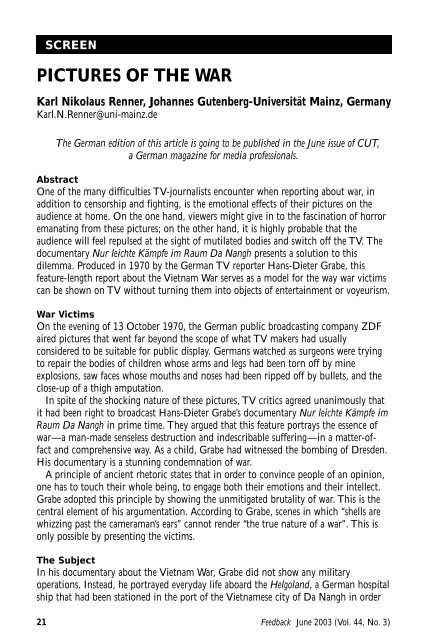JUNEFeedback
Issue 3 - Broadcast Education Association
Issue 3 - Broadcast Education Association
You also want an ePaper? Increase the reach of your titles
YUMPU automatically turns print PDFs into web optimized ePapers that Google loves.
SCREENPICTURES OF THE WARKarl Nikolaus Renner, Johannes Gutenberg-Universität Mainz, GermanyKarl.N.Renner@uni-mainz.deThe German edition of this article is going to be published in the June issue of CUT,a German magazine for media professionals.AbstractOne of the many difficulties TV-journalists encounter when reporting about war, inaddition to censorship and fighting, is the emotional effects of their pictures on theaudience at home. On the one hand, viewers might give in to the fascination of horroremanating from these pictures; on the other hand, it is highly probable that theaudience will feel repulsed at the sight of mutilated bodies and switch off the TV. Thedocumentary Nur leichte Kämpfe im Raum Da Nangh presents a solution to thisdilemma. Produced in 1970 by the German TV reporter Hans-Dieter Grabe, thisfeature-length report about the Vietnam War serves as a model for the way war victimscan be shown on TV without turning them into objects of entertainment or voyeurism.War VictimsOn the evening of 13 October 1970, the German public broadcasting company ZDFaired pictures that went far beyond the scope of what TV makers had usuallyconsidered to be suitable for public display. Germans watched as surgeons were tryingto repair the bodies of children whose arms and legs had been torn off by mineexplosions, saw faces whose mouths and noses had been ripped off by bullets, and theclose-up of a thigh amputation.In spite of the shocking nature of these pictures, TV critics agreed unanimously thatit had been right to broadcast Hans-Dieter Grabe’s documentary Nur leichte Kämpfe imRaum Da Nangh in prime time. They argued that this feature portrays the essence ofwar—a man-made senseless destruction and indescribable suffering—in a matter-offactand comprehensive way. As a child, Grabe had witnessed the bombing of Dresden.His documentary is a stunning condemnation of war.A principle of ancient rhetoric states that in order to convince people of an opinion,one has to touch their whole being, to engage both their emotions and their intellect.Grabe adopted this principle by showing the unmitigated brutality of war. This is thecentral element of his argumentation. According to Grabe, scenes in which “shells arewhizzing past the cameraman’s ears” cannot render “the true nature of a war”. This isonly possible by presenting the victims.The SubjectIn his documentary about the Vietnam War, Grabe did not show any militaryoperations. Instead, he portrayed everyday life aboard the Helgoland, a German hospitalship that had been stationed in the port of the Vietnamese city of Da Nangh in order21Feedback June 2003 (Vol. 44, No. 3)
















